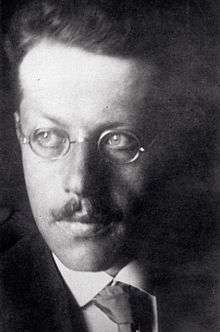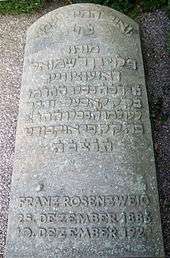Franz Rosenzweig
| Franz Rosenzweig | |
|---|---|
 | |
| Born |
December 25, 1886 Kassel, German Empire |
| Died |
December 10, 1929 (aged 42) Frankfurt, Germany |
| Era | 20th-century philosophy |
| Region | Western Philosophy |
| School | Existentialism |
Main interests | Philosophy of religion |
|
Influences
| |
Franz Rosenzweig (December 25, 1886 – December 10, 1929) was a German Jewish theologian, philosopher, and translator.
Early life
Franz Rosenzweig was born in Kassel, Germany to a middle-class, minimally observant, Jewish family. He studied history and philosophy at the universities of Göttingen, Munich, and Freiburg.
Rosenzweig, under the influence of his cousins and his close friend Eugen Rosenstock-Huessy, considered converting to Christianity. Determined to embrace the faith as the early Christians did, he resolved to live as an observant Jew first, before becoming Christian. After attending Yom Kippur services at a small Orthodox synagogue in Berlin, he underwent a mystical experience. As a result, he became a baal teshuva.[1] Although he never recorded what transpired, he never again entertained converting to Christianity. In 1913, he turned to Jewish philosophy. His letters to his friend Eugen Rosenstock-Huessy, whom he had nearly followed into Christianity, have been published as Judaism Despite Christianity. Rosenzweig was a student of Hermann Cohen, and the two became close. While writing a doctoral dissertation on Georg Wilhelm Friedrich Hegel, Hegel and the State, Rosenzweig turned against idealism and sought a philosophy that did not begin with an abstract notion of the human.
The Star of Redemption

Rosenzweig's major work is The Star of Redemption (first published in 1921). It is a description of the relationships between God, humanity, and the world, as they are connected by creation, revelation and redemption. If one makes a diagram with God at the top, and the World and the Self below, the inter-relationships generate a Star of David map. He is critical of any attempt to replace actual human existence with an ideal. In Rosenzweig's scheme, revelation arises not in metaphysics but in the here and now. We are called to love God, and to do so is to return to the world, and that is redemption.
A translation into English was prepared by Professor William Wolfgang Hallo.[2]
Collaboration with Buber
Rosenzweig, while critical of Jewish scholar Martin Buber's early work, became close friends with him upon their meeting. Buber was a Zionist, but Rosenzweig felt that a return to Israel would embroil the Jews into a worldly history they should eschew. Rosenzweig criticized Buber’s dialogical philosophy, because it is based not only on the I-Thou relation, but also on I-It, a notion that Rosenzweig rejected. He thought the counterpart to I-Thou should be He-It, namely “as He said and it became”: building the "it" around the human "I" — the human mind — is an idealistic mistake.[3] Rosenzweig and Buber worked together on a translation of the Torah from Hebrew to German. The translation, while contested, has led to several other translations (in other languages) using the same methodology and principles. Their publications concerning the nature and philosophy of translation are still widely read.
Educational activities
Rosenzweig, unimpressed with the impersonal learning of the academy, founded the House of Jewish Learning in Frankfurt in 1920, which sought to engage in dialogue with human beings rather than merely accumulate knowledge. The Lehrhaus, as it was known in Germany, produced many prominent Jewish intellectuals. In October 1922, Rudolf Hallo took over the leadership of the Lehrhaus. It stayed open until 1930 and was reopened by Martin Buber in 1933.
Illness and death

Rosenzweig suffered from the muscular degenerative disease Amyotrophic Lateral Sclerosis (also known as Lou Gehrig's Disease). Towards the end of his life, he had to write with the help of his wife, Edith, who would recite letters of the alphabet until he indicated for her to stop, continuing until she could guess the word or phrase he intended (or, at other times, Rosenzweig would point to the letter on the plate of his typewriter). They also developed a communication system based on him blinking his eyes.
Rosenzweig's final attempt to communicate his thought, via the laborious typewriter-alphabet method, consisted in the partial sentence: "And now it comes, the point of all points, which the Lord has truly revealed to me in my sleep, the point of all points for which there—". The writing was interrupted by his doctor, with whom he had a short discussion using the same method. When the doctor left, Rosenzweig did not wish to continue with the writing, and he died on the night of December 10, 1929, in Frankfurt, the sentence left unfinished.[4]
Rosenzweig was buried on December 12, 1929. There was no eulogy; Buber read Psalm 73.[5]
See also
References
- ↑ Emil L. Fackenheim (1994). To Mend the World. Indiana University Press. ISBN 0-253-32114-X.
- ↑ Rosenzweig, Franz. Der Stern Der Erlosung [The Star of Redemption]. Trans. William W. Hallo. New York: Holt, Rinehart and Winston. 1971. ISBN 0-03-085077-0.
- ↑ Franz Rosenzweig in Encyclopedia Judaica by Ephraim Meir and Rivka G. Horwitz, Thomson Gale, 2007.
- ↑ Nahum N. Glatzer, Franz Rosenzweig: His Life and Thought (New York: Schocken Books, 1961, 2nd edn.), pp. 174–6.
- ↑ Maurice Friedman, Martin Buber's Life and Work, page 410 (Wayne State University Press, 1988). ISBN 0-8143-1944-0
Further reading
- Anckaert, Luc & Casper, Bernhard Moses Casper, Franz Rosenzweig - a primary and secondary bibliography (Leuven, 1990)
- Amir, Yehoyada, "Towards mutual Listening: the Notion of Sermon in Franz Rosenzweig's Philosophy", in: Alexander Deeg, Walter Homolka & Heinz–Günter Schöttler (eds.), "Preaching in Judaism and Christianity" (Berlin, 2008), 113–130
- Amir, Yehoyada, Turner, Joseph (Yossi), Brasser, Martin, "Faith, Truth, and Reason - New Perspectives on Franz Rosenzweig's Star of Redemption" (Karl Alber, 2012)
- Belloni, Claudio, Filosofia e rivelazione. Rosenzweig nella scia dell’ultimo Schelling, Marsilio, Venezia 2002
- Bienenstock, Myriam Cohen face à Rosenzweig. Débat sur la pensée allemande (Paris, Vrin, 2009)
- Bienenstock, Myriam (ed.). Héritages de Franz Rosenzweig. "Nous et les autres" (Paris, éditions de l'éclat, 2011)
- Gibbs, Robert, Correlations in Rosenzweig and Levinas (1994)
- Glatzer, Nahum Norbert Essays in Jewish thought (1978)
- Glatzer, Nahum Norbert, Franz Rosenzweig - his life and thought (New York, 1953)
- Guttmann, Isaak Julius. Philosophies of Judaism : the history of Jewish philosophy from biblical times to Franz Rosenzweig (New York, 1964)
- Maybaum, Ignaz Trialogue between Jew, Christian and Muslim (London, 1973)
- Mendes-Flohr, Paul R., German Jews - a dual identity (New Haven, CT, 1999)
- Miller, Ronald Henry Dialogue and disagreement - Franz Rosenzweig's relevance to contemporary Jewish-Christian understanding (Lanham, 1989)
- Putnam, Hilary Jewish philosophy as a guide to life - Rosenzweig, Buber, Levinas, Wittgenstein (Bloomington, IN, 2008)
- Rahel-Freund, Else Die Existenz philosophie Franz Rosenzweigs (Breslau 1933, Hamburg 1959)
- Rahel-Freund, Else Franz Rosenzweig's philosophy of existence - an analysis of The star of redemption (The Hague, 1979)
- Samuelson, Norbert Max, The Legacy of Franz Rosenzweig: Collected Essays (Cornell University Press, 2004)
- Santner, Eric L. The Psychotheology of Everyday Life - Reflections on Freud and Rosenzweig (Chicago, IL, 2001)
- Schwartz, Michal. "Metapher und Offenbarung. Zur Sprache von Franz Rosenzweigs Stern der Erloesung" (Berlin, 2003)
- Tolone, Oreste. "La malattia immortale. Nuovo pensiero e nuova medicina tra Rosenzweig e Weizsäcker", (Pisa 2008)
External links
| Wikimedia Commons has media related to Franz Rosenzweig. |
| Wikiquote has quotations related to: Franz Rosenzweig |
- Arnold Betz's essay on Rosenzweig and The Star of Redemption at the Vanderbilt University
- Franz Rosenzweig's Der Stern der Erlösung online (in German)
- Review of The Star of Redemption by Spengler at Asia Times
- Stanford Encyclopedia of Philosophy entry of Franz Rosenzweig
- Guide to the Papers of Franz Rosenzweig (1886-1929) at the Leo Baeck Institute, New York.
- Guide to the Franz Rosenzweig - Martin Buber notebooks at the Leo Baeck Institute, New York.